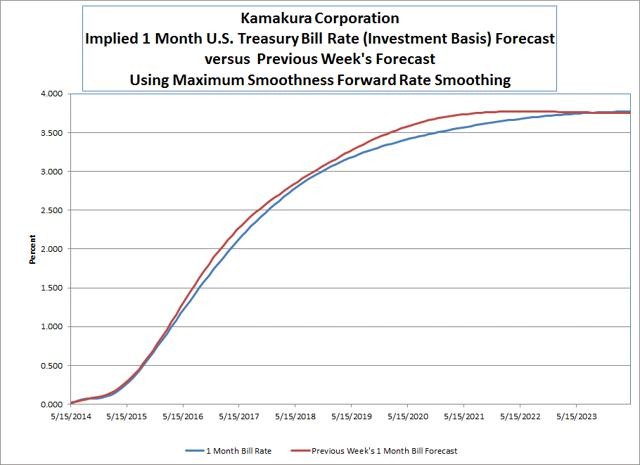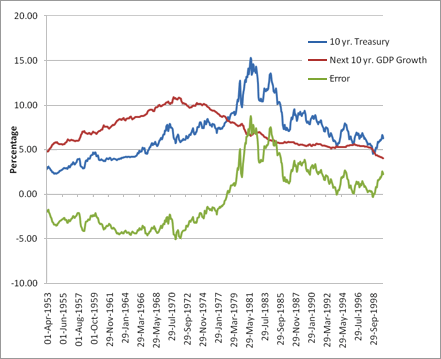10 Year Treasury Rate Forecast Where to Next
Post on: 16 Март, 2015 No Comment

What is the ten year treasury rate? (The yield on on the 10 year US Treasury note.)
As of July 5th, the 10 year treasury rate is 2.71%.
One month before, the rate was 2.09%.
One year before, the rate was was 1.60%
While rates have dramatically increased in June / early July 2013, it is far away from where it was trading in the beginning of 2011 when rates were a tad below 3.5%. In fact, on the graph of the 10 year treasury below it doesnt look like the rate has even broken its downward trend.
Where is the 10 year rate going from a technical (charting) perspective?
Lets say that you knew nothing about the fundamental reasons for the 10 year interest rate moving and only had the chart to use for forecasts. What conclusions would you make?
- If you drew a line from the highs in 2007, 2010 and 2011, the line would be right around where the 1o year treasury rate is currently trading. A trader focused on charts would expect there to be some resistance to the rate going higher based on this trend.
- If this line was broken and the rate moved higher, the next major point where rates seem to have resistance is all the way at 4.0%, which 10 year treasury rates flirted with but could note make a sustained move above from 2008 2011.
Where is the 10 year treasury rate going from a fundamental perspective?
While most people expect that over the next 5 to 10 years rates will be rising, the question is the timing of rising rates. Since 2009, The Federal Reserve has done everything in its power to lower interest rates in general, and long-term rates in particular. The FED has been buying 85 billion dollars worth of bonds per month (aka QE3) pushing down yields, switching its portfolio to hold more long-term bonds (QE2) and setting short-term interest rates (FED Funds Target Rate) a smidgen above zero. However, the market knew that all of these drastic measures had to end eventually. The recent rise in rates reflects the markets view that the FED will be reversing course soon.
Bill Gross of PIMCO Thinks The Markets Anticipation Of The FED Reversing Course Is Too Early
The 10-year Treasury – may be as much as 35 basis points too cheap. They belong in our opinion at 2.20% instead of 2.55%.
- Bill Gross, The Tipping Point, July 2013
Here is a summary of why Bill Gross thinks that the FED will reverse course less quickly than the rest of the market:
- For the FED to reverse course, the economy needs to be strong. While the FED has started to talk about a time when they will stop buying bonds, this is based on the unemployment rate starting to head towards 6.5%. Gross doesnt think that unemployment will reach 7% in the next year. If he is right, it will tough for the FED to argue that the economy is strong enough to change policy.
- The FED has said it has an inflation target of 2%. With inflation closer to 1% than 2%, the FED will have a hard time arguing that changing policy makes sense from the standpoint of creating price stability.
- There has been too much focus on the FED stopping its purchase of bonds and not enough on the FEDs position on short-term rates. The FED has said that it will keep the FED Funds Target Rate stable (between 0.0 and 0.25%) for some time after it stops buying bonds. With short-term rates effectively being zero, there is only so far that the 10 year treasury rate can rise.
Learn Bonds 10 Year Treasury Rate Forecast

The question which Bill Gross doesnt ask or answer is why would anyone want to own a 10 year treasury that pays 2.0% or 2.2%, when they can own a high quality stock with growth potential that consistently pays a dividend of 1.5 — 2.0%. Over the last few years, the answer to that question has been the relatively safety and security of treasuries relative to other investments. However, with a change in FED policy inevitable (whether its 1 year or 3 years down the road, Treasuries now look like a risky investment. However, I do believe Bill Gross is right in that many are predicting a change in FED policy too soon. Learn Bonds prediction of the 10 Year Treasury rate for the next year is between 2.0% and 3.0%.
Below is an older article we published with the same title in February, 2013. I have kept article because I think it illustrates an two important points. The 10 year treasury rate tends to shoot up and then come back to earth in an almost annual cycle. Typically, this process happens near the end or beginning of the year. The recent dramatic rate move does not correspond to this seasonality.
So far 2013 has been an exciting year for the bond market. Junk bond yields have dropped below 6% for the first time ever, while at the same time the yield on the 10 year treasury has moved significantly higher. With this in mind, I thought it would be constructive to have a look back at what we can learn from this, and what insight current price levels may give us into future price action.
The 10 Year Treasury
As you can see from the below chart, the 10 year treasury yield has been on a steady march higher since late December, recently crossing back above 2% for the first time since April of last year.
What caused the rise in yields?
In my opinion there are several different factors, however all of them relate either directly or indirectly to the Fed. If you pay much attention to the news this may seem counterintuitive, as everything you read says the Fed’s intervention into the market is keeping rates low. As I explain here however, this is not actually the case. In September of 2012 the Fed announced unlimited quantitative easing, and that they were increasing the amount of treasuries and mortgage backed securities that they were buying to $85 Billion a month.
What really got the market moving however was when they announced that they would be specifically targeting unemployment, with the goal of continuing their intervention into the market until the unemployment rate drops below 6.5%. This increased the market’s inflation expectations, sending rates higher.
The “resolution” or at least kicking of the fiscal cliff can down the road also played a role, as it removed a level of uncertainty from the market early in the year. All of this, combined with a more stable situation in Europe, has investors in a “risk on” mood. When this happens money flows out of bonds and into stocks, sending bond yields higher (their prices lower) and stock prices higher.
The bursting of a bond bubble?
If you follow the markets at all you are probably reading at least 1 article a day about the bursting of “the bond bubble ”. What those articles authors fail to mention however, is that they have been writing the same article for years now. This is the 5th year in a row that the 10 year treasury rate has risen going into the new year, only to later continue the downward trend towards all time lows. In fact, so far at least, the recent move is actually one of the least dramatic we have seen. However, you wouldn’t know it from the increasing chorus of headlines declaring that the recent rise in rates signals an end to the “bond bubble”
Just because the market has done something in the past is certainly no reason to think that it is going to continue to do so. However I do think it helps put the recent move higher in rates into perspective.
My 10 Year Treasury Rate Forecast
There is no doubt that with rates so low the risk is to the upside. However, this has been the most euphoric start to the year that I remember since the financial crisis, and we have seen around a 25 basis point move in the 10 year treasury. Since the mood of the market is already so elevated, I am skeptical that we are going to see things become a lot more euphoric in 2013 than they already are.
Although the situation here in the US and Europe has certainly improved, there are still many dangers lurking in the shadows. While I hope I am wrong, I suspect that one of these dangers will rear its ugly head in the relatively near future, putting a near term cap on both stock prices and the 10 year treasury yield.
With this in mind I anticipate that we will likely spend 2013 bouncing between the 2.20% and 1.80% levels. This means that while there will be some opportunities for traders, the long term investor is likely to find better value elsewhere.
For more reasons why I do not think there is a bond bubble go here .
Want to learn how to generate more income from your portfolio so you can live better? Get our free guide to income investing here .














